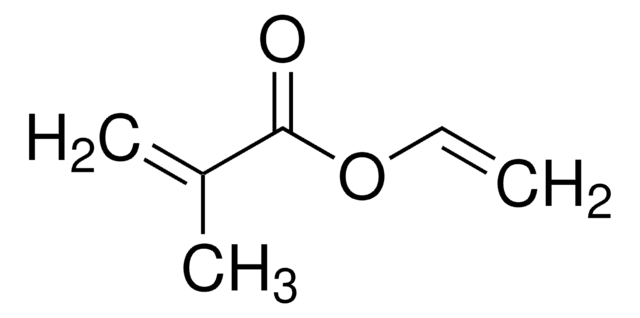477028
2-Hydroxyethyl methacrylate
≥99%, contains ≤50 ppm monomethyl ether hydroquinone as inhibitor
Sinónimos:
1,2-Ethanediol mono(2-methylpropenoate), Glycol methacrylate, HEMA
About This Item
Productos recomendados
densidad de vapor
5 (vs air)
presión de vapor
0.01 mmHg ( 25 °C)
Ensayo
≥99%
contiene
≤50 ppm monomethyl ether hydroquinone as inhibitor
índice de refracción
n20/D 1.453 (lit.)
bp
67 °C/3.5 mmHg (lit.)
densidad
1.073 g/mL at 25 °C (lit.)
temp. de almacenamiento
2-8°C
cadena SMILES
CC(=C)C(=O)OCCO
InChI
1S/C6H10O3/c1-5(2)6(8)9-4-3-7/h7H,1,3-4H2,2H3
Clave InChI
WOBHKFSMXKNTIM-UHFFFAOYSA-N
¿Está buscando productos similares? Visita Guía de comparación de productos
Categorías relacionadas
Descripción general
Aplicación
Palabra de señalización
Warning
Frases de peligro
Consejos de prudencia
Clasificaciones de peligro
Eye Irrit. 2 - Skin Irrit. 2 - Skin Sens. 1
Código de clase de almacenamiento
10 - Combustible liquids
Clase de riesgo para el agua (WGK)
WGK 1
Punto de inflamabilidad (°F)
222.8 °F - closed cup
Punto de inflamabilidad (°C)
106 °C - closed cup
Elija entre una de las versiones más recientes:
¿Ya tiene este producto?
Encuentre la documentación para los productos que ha comprado recientemente en la Biblioteca de documentos.
Los clientes también vieron
Artículos
With dentists placing nearly 100 million dental fillings into patients′ teeth annually in the U.S. alone, polymeric composite restoratives account for a very large share of the biomaterials market.
Nuestro equipo de científicos tiene experiencia en todas las áreas de investigación: Ciencias de la vida, Ciencia de los materiales, Síntesis química, Cromatografía, Analítica y muchas otras.
Póngase en contacto con el Servicio técnico














